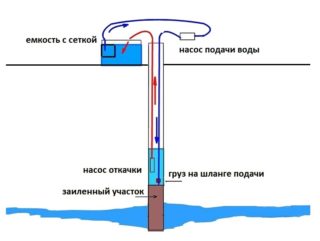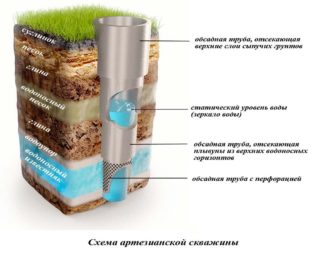For correct and long-term operation, pumping equipment must sometimes be taken out of the well and inspected, cleaned, and repaired. During this work, the pump may get stuck or break off and sink to the bottom of the source. There are several ways in which aggregates are lifted or pulled to the surface safe and sound.
Why a pump in a well can get stuck or break off

How well the pump will be serviced depends on the quality of the installation. If the technician left the cable in a saggy state and it got caught between the equipment body and the borehole wall, it is likely that he will interfere with getting the device. If the casing is too narrow, any foreign object caught between the wall and the unit can jam it inside. It is usually recommended to buy a pump with a diameter 2 cm less than the pipe diameter. During dismantling work, remove all tools away from the well.
To avoid sagging, the electrical cable and cable are fastened with clamps during installation and at the same time lowered down. Raise in the same way: make sure that the cable or cable does not get between the walls of the body and the pipe. They do not use cheap materials that stretch and deform strongly. It is better to use a cable made of stainless steel.
To eliminate jamming, several methods are used:
- Something heavy is lowered down, for example, a crowbar tied to a cable or a metal dumbbell. In this case, do not hold the rope under tension, to which the pump is attached, otherwise it may break. A heavy object must be firmly fixed so that it also does not drown. The weight can cause the pump to level out in the well.
- A device is lowered with which a piece of equipment can be hooked. The device is popularly called a "cat". You can simply use a homemade hook and lower it into the hole. The end of the hook must not be long, or there is not enough room inside to hook the equipment.
- If the pump is changed to another, use a pipe with a serrated end or a sharp rod, with which you can "prick" the device and pull it out. This method is used when the pump is sinking.
Some owners remove the units along with part of the casing, then put it in place. In any case, this is better than a dangling cable. If you take the risk and leave the equipment at the bottom, the productivity of the well will drop. In this case, you need to select the next pump with an upper water intake.
Spring method: you need to know exactly the diameter of the body and select the appropriate size for the spring. Its top is attached to the bar and lowered down, screwed onto the body and then lifted all together. The method is suitable when you need to get a submersible pump out of the well if it has come off and is in a vertical position at the bottom.
The second option is a pipe with a smaller diameter than the well, but larger than the pump. On the reverse side, a shut-off valve is needed so that everything that gets into the pipe does not fall out during lifting. Put on the unit and lift up together with the pipe.
Silting up

In some cases, the body of a submersible pump is silted up. This word means:
- immersion in the sand;
- lime plug;
- organic matter at the bottom, which, after a long downtime of the well, also dries up, which complicates the lifting measures.
Sanding of the well usually occurs along the edges of the casing. The device, as it were, becomes buried from all sides. It is useless to pull on the cable - it may break. The output is as follows:
- Swinging up and down. It can take a long time. In this case, water gets between the grains of sand and the pump is released.
- Rinsing with water from above. To do this, you need to lower the hose and let the water flow under pressure. Along with this, continue to slowly swing the body.
- The method of washing out the sand is airlift. The technology consists in lowering the pipe into the well and using the air supplied under pressure to break up the sandy deposits. In very narrow wells, it is not always possible to insert an additional pipe, since its lower edge is a hook in order to act on the sand from below.
Silting with lime deposits is eliminated with descaling agents. They are simply poured into the well and wait for the lime to dissolve. Citric acid or vinegar will do. After that, the well must be completely pumped out and before use, wait until new water is collected.
If the source has not been used for a long time, sediments can accumulate. In this case, it usually takes up to 2 days to soak them and pull the pump out of the well if it gets stuck in the pipe. Home pressure may not be enough, then it is better to invite firefighters with a sleeve.
Knowing that there is water with lime on the site, it is necessary to clean it at least 1 time in 3 years. Wells drilled on limestone are better equipped with plastic pipes - less sediment adheres to them.
Casing damage
First you need to try to twist the body around its axis in order to get around the obstacle that has arisen on the way. If it is small, the method will work. If the pipe distortion is severe, it must be retrieved.
More problems arise if the source is very deep and it is impossible to insert an additional pipe or any instrument into it. Therefore, artesian wells require high-quality installation and the use of durable materials.
Long-term operation of the vibration pump may damage the pipe due to vibrations that occur regularly. To avoid this, rubber rings are put on the body. If the equipment slides down easily but gets jammed when you try to pull it out, then a segment of the pipe is damaged.
What not to do
Even if the situation is not hopeless, improper actions can worsen it, and then it will definitely not work to lift the pump out of the well with your own hands - you will have to call a special service that is engaged in pulling out flooded pumps and removing foreign objects from the well.
Do not use brute force until the cause of the equipment jamming inside the source has been identified. If unsuitable materials were used during installation, the cable may break and break.
It is not recommended to pull out a heavy pump using only an electric cable. It is much weaker and can break at any moment. For a safety net, you need to use hooks and work at the same time.
Poorly connected parts from pipes and hoses must not be lowered inside. In the process, they can remain in the well and further complicate the task.
Do not attach heavy equipment to poor quality cables. They corrode and lose strength when exposed to water.
It is not advisable to install a vibration type of equipment. During operation, it contributes to the accumulation of sludge and damages the pipe walls. A centrifugal pump is most suitable for continuous operation.
Prophylaxis
To avoid debris entering the source, you must use a factory-made borehole head that fits snugly against the edge. Soil particles can penetrate between poorly connected parts of the pipe, especially concrete ones, which are simply stacked on top of each other, so it is necessary to seriously approach the issue of material selection.
When buying a pump, it is advisable to select it in such a way that there is more space at the edges - between the pipe walls and the body. In this case, even if the shaft is deformed, the device can be obtained using folk methods.
Well cleaning is much cheaper than drilling a new one, therefore, if there is a large amount of sand in the soil, it is necessary to call a team for a professional inspection of the source. Do-it-yourself cleaning. In order to carry out preventive measures less often, when arranging a well, a filter is installed that prevents sand and soil from entering the pump area. In this case, the diameter of the mechanical filter is important.
If the well is not in operation, at least once every 3 months, it is necessary to pump out about 100 liters of liquid from it so that organic matter and soil do not clog the pump.









